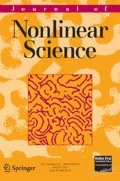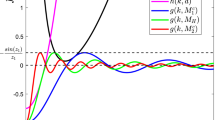Abstract
In this paper we extend the famous Keller–Segel model for the chemotactic movement of motile species to some multi-species chemotaxis equations. The presented multi-species chemotaxis models are more general than those introduced so far and also include some interaction effects that have not been studied before. For example, we consider multi-species chemotaxis models with attraction and repulsion between interacting motile species. For some of the presented new models we give sufficient conditions for the existence of Lyapunov functionals. These new results are related to those of Wolansky (Scent and sensitivity: equilibria and stability of chemotactic systems in the absence of conflicts, preprint, 1998; Eur. J. Appl. Math. 13:641–661, 2002). Furthermore, a linear stability analysis is performed for uniform steady states, and results for the corresponding steady state problems are established. These include existence and nonexistence results for non-constant steady state solutions in some special cases.
Similar content being viewed by others
References
Adler, J., Tso, W.-W.: Decision making in bacteria: chemotactic response of Escherichia coli to conflict stimuli. Science 184, 1292 (1974)
Alt, W.: Vergleichssätze für Quasilineare Elliptisch-Parabolische Systems Partieller Differentialgleichungen. Habilitation. Ruprecht-Karl-Universität, Heidelberg (1980)
Boon, J.-P., Herpigny, B.: Model for chemotactic bacterial bands. Bull. Math. Biol. 48, 1–19 (1986)
Burger, M., Di Francesco, M., Pietschmann, J.-F., Schlake, B.: Nonlinear cross-diffusion with size exclusion. Preprint, Universität Münster, January 2010
Espejo Arenas, E.E., Stevens, A., Velázquez, J.J.L.: Simultaneous finite time blow-up in a two-species model for chemotaxis. Analysis 29, 317–338 (2009)
Fasano, A., Mancini, A., Primicerio, M.: Equilibrium of two populations subjected to chemotaxis. Math. Models Methods Appl. Sci. 14, 503–533 (2004)
Feireisl, E., Laurençot, P., Petzeltová, H.: On convergence to equilibria for the Keller–Segel chemotaxis model. J. Differ. Equ. 236, 551–569 (2007)
Frymier, P.D., Ford, R.M., Cummings, P.T.: Cellular dynamics simulations of bacterial chemotaxis. Chem. Eng. Sci. 48, 687–699 (1993)
Frymier, P.D., Ford, R.M., Cummings, P.T.: Analysis of bacterial migration: I. Numerical solution of balance equation. AIChE J. 40, 704–715 (1994)
Gajewski, H., Zacharias, K.: Global behavior of a reaction-diffusion system modelling chemotaxis. Math. Nachr. 195, 77–114 (1998)
Homma, M., Oota, H., Kojima, S., Kawagishi, I., Imae, Y.: Chemotactic responses to an attractant and a repellent by the polar and lateral flagellar systems of Vibrio alginolyticus. Microbiology 142, 2777–2783 (1996)
Horstmann, D.: Lyapunov functions and L p-estimates for a class of reaction-diffusion systems. Colloq. Math. 87, 113–127 (2001)
Horstmann, D.: From 1970 until present: the Keller–Segel model in chemotaxis and its consequences I. Jahresber. DMV 105, 103–165 (2003)
Horstmann, D., Lucia, M.: Nonlocal elliptic boundary value problems related to chemotactic movement of mobile species. RIMS Kôkyûroku Bessatsu B 15, 39–72 (2009)
Horstmann, D., Stevens, A.: A constructive approach to traveling waves in chemotaxis. J. Nonlinear Sci. 14, 1–25 (2004)
Keller, E.F., Segel, L.A.: Initiation of slime mold aggregation viewed as an instability. J. Theor. Biol. 26, 399–415 (1970)
Kelly, F.X., Dapsis, K., Lauffenburger, D.A.: Effects of bacterial chemotaxis on dynamics of microbial competition. Microb. Ecol. 16, 115–131 (1988)
Kuiper, H.J.: A priori bounds and global existence for a strongly coupled quasilinear parabolic system modeling chemotaxis. Electron. J. Differ. Equ. 2001, 1–18 (2001), electronic only
Kurokiba, M., Ogawa, T.: Finite time blow-up of the solution for a nonlinear parabolic equation of drift-diffusion type. Differ. Integral Equ. 16, 427–452 (2003)
Lauffenburger, D.A.: Quantitative studies of bacterial chemotaxis and microbial population dynamics. Microb. Ecol. 22, 175–185 (1991)
Lauffenburger, D.A., Calcagno, B.: Competition between two microbial populations in a non-mixed environment: effect of cell random motility. Biotech. Bioeng. 25, 2103–2125 (1983)
Lauffenburger, D.A., Aris, R., Keller, K.: Effects of cell motility and chemotaxis on microbial population growth. Biophys. J. 40, 209–219 (1982)
Le, D., Smith, H.L.: Steady states of models of microbial growth and competition with chemotaxis. J. Math. Anal. Appl. 229, 295–318 (1999)
Le, D.: Coexistence with chemotaxis. SIAM J. Math. Anal. 32, 504–521 (2000)
Matsuura, T., Oikawa, T., Wakabayashi, T., Shingai, R.: Effect of simultaneous presentation of multiple attractants on chemotactic response of nematode Caenorhabditis elegans. Neurosci. Res. 48, 419–429 (2004)
Nagai, T., Senba, T., Yoshida, K.: Application of the Moser–Trudinger inequality to a parabolic system of chemotaxis. Funkc. Ekvacioj, Ser. Int. 40, 411–433 (1997)
Painter, K.J., Hillen, T.: Volume-filling and quorum-sensing in models for chemosensitive movement. Can. Appl. Math. Q. 10, 501–543 (2002)
Pearce, I.G., Chaplain, M.A.J., Schofield, P.G., Anderson, A.R.A., Hubbard, S.F.: Chemotaxis-induced spatio-temporal heterogeneity in multi-species host-parasitoid systems. J. Math. Biol. 55, 365–388 (2007)
Post, K.: A non-linear parabolic system modeling chemotaxis with sensitivity functions. Dissertation, Humboldt-Universität zu Berlin, Institut für Mathematik (1999)
Senba, T., Suzuki, T.: Local and norm behavior of blowup solutions to a parabolic system of chemotaxis. J. Korean Math. Soc. 37, 929–941 (2000)
Schaaf, R.: Stationary solutions of chemotaxis systems. Trans. Am. Math. Soc. 292, 531–556 (1985)
Strauss, I., Frymier, P.D., Ford, R.M., Cummings, P.T.: Analysis of bacterial migration: II. Studies with multiple attractant gradients. AIChE J. 41, 402–414 (1995)
Struwe, M., Tarantello, G.: On multivortex solutions in Chern–Simons Gauge theory. Boll. Unione Mat. Ital. B (8) 1, 109–121 (1998)
Tang, X., Tao, Y.: Analysis of a chemotaxis model for multi-species host-parasitoid interactions. Appl. Math. Sci. 2, 1239–1252 (2008)
Tsang, N., Macnab, R., Koshland, J.: Common mechanism for repellents and attractants in bacterial chemotaxis. Science 181, 60 (1973)
Weijer, C.: Dictyostelium morphogenesis. Curr. Opin. Genet. Dev. 14, 392–398 (2004)
Wolansky, G.: Scent and sensitivity: equilibria and stability of chemotactic systems in the absence of conflicts. Preprint (1998)
Wolansky, G.: Multi-components chemotactic system in absence of conflicts. Eur. J. Appl. Math. 13, 641–661 (2002)
Author information
Authors and Affiliations
Corresponding author
Additional information
Communicated by P.K. Maini.
Rights and permissions
About this article
Cite this article
Horstmann, D. Generalizing the Keller–Segel Model: Lyapunov Functionals, Steady State Analysis, and Blow-Up Results for Multi-species Chemotaxis Models in the Presence of Attraction and Repulsion Between Competitive Interacting Species. J Nonlinear Sci 21, 231–270 (2011). https://doi.org/10.1007/s00332-010-9082-x
Received:
Accepted:
Published:
Issue Date:
DOI: https://doi.org/10.1007/s00332-010-9082-x




